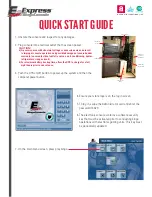
EyeLink II User Manual version 2.12
(07/02/2006)
©
2002-2006 SR Research Ltd.
85
what data can be expected in the START...END block. These are most easily
processed by creating a set of flags for each possible data option (left-eye events,
right-eye samples, sample velocity, etc.), clearing these when the START line is
encountered, and setting the appropriate flags when keywords ("LEFT", "VEL",
etc.) are encountered in a data specification line.
•
PRESCALER <prescaler>
If gaze-position data or gaze-position resolution are used for saccades and
events are used, they must be divided by this value. For EDF2ASC, the
prescaler is always 1. Programs that write integer data may use a larger
prescaler (usually 10) to add precision to the data.
•
VPRESCALER <prescaler>
If velocity data is present, it must be divided by this value. For EDF2ASC, the
prescaler is always 1. Programs that write integer data may use a larger
prescaler (usually 10) to add precision to the data.
•
EVENTS <data type> <eyes> <data options>
This specifies what types of data is present in event lines, as a sequence of
keywords. The <data type> is one of "GAZE", "HREF" or "PUPIL". The eyes
recorded will be one or two words, "LEFT", "RIGHT", or both. The <data option>
keywords currently supported are:
o
"RES" for resolution data (both may be present).
o
“RATE” for the sample rate (250.00 or 500.00)
o
“TRACKING” for the tracking mode (P = Pupil, CR = Corneal
Reflection)
o
“FILTER” for the filter level used (0=off, 1=standard, 2=extra)
•
SAMPLES <data type> <eyes> <data options>
This specifies what types of data is present in sample lines, as a sequence of
keywords. The <data type> is one of "GAZE", "HREF" or "PUPIL". The eyes
recorded will be one or two words, "LEFT", "RIGHT", or both. The <data option>
keywords currently supported are:
o
"VEL" for instantaneous velocity data
o
"RES" for resolution data (both may be present).
o
“RATE” for the sample rate (250.00 or 500.00)
o
“TRACKING” for the tracking mode (P = Pupil, CR = Corneal
Reflection)
o
“FILTER” for the filter level used (0=off, 1=standard, 2=extra)
















































